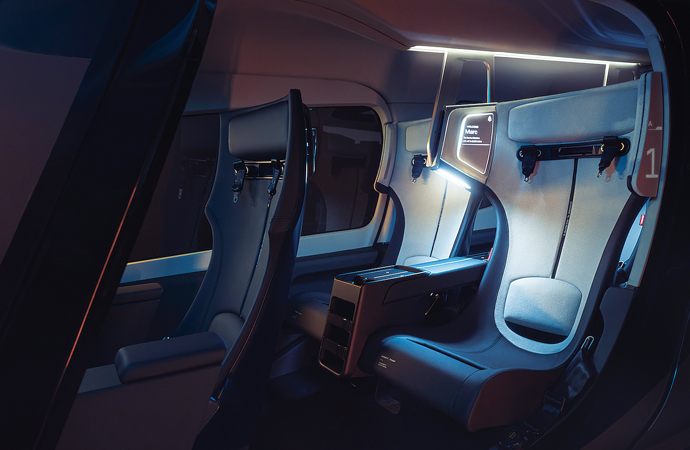The High-Stakes Race for the World’s First Air Taxi Service
More than 200 companies have raised billions of dollars to develop wildly different prototypes
April 19, 2023

Joby Aviation’s five-seat air taxi / Photo: Courtesy of Bradley Wentzel
Picture it: You awaken to the smell of freshly brewed coffee and a hot breakfast as the purser gently returns your business class seat from horizontal to upright after a few hours of solid slumber. The dawn sun blazes through the window as you descend into Newark Liberty International Airport, the perfect red-eye flight from the West Coast. And then you spend two hours snarled in traffic inching your way into Manhattan. United Airlines hopes to end that maddening fast-fast-slow that any seasoned traveler knows well. The company recently announced the first proposed route of an air taxi service utilizing an entirely novel type of aircraft, the so-called eVTOL (electric vertical takeoff and landing). Drawing on huge advances in electric motors and battery technology, eVTOLs typically have multiple propellers that allow them to take off vertically, then tilt to allow them to fly like a plane. And unlike helicopters, with their cacophonous thumping, they promise to be as quiet as the hum of a refrigerator, opening the possibility of inter- and intracity flights. United hopes to launch the service in 2025.

Interior of Archer Aviation’s Midnight aircraft / Photo: Courtesy of Archer
Ask people in the street about flying cars—a label no one in the industry particularly likes—and they would most likely dismiss the concept as a Jetsons-style fantasy. This is understandable. The sector has thus far been best known for artists’ renderings and unmet promises. Yet quietly, a high-stakes race to develop the world’s first air taxi service has begun. More than 200 companies have raised billions of dollars to develop wildly different prototypes of eVTOLs. One industry expert has dubbed this a new “Wright Brothers era” of invention.
Near the front of the pack is San Jose, California-based Archer Aviation, United’s partner, and its rival, Joby Aviation, located 33 miles down the road in Santa Cruz. Joby, founded by JoeBen Bevirt in 2009, has raised more than $1.8 billion—far more than any of its competitors. Its vehicle has flown more hours and is furthest along the circuitous path of convincing the Federal Aviation Administration that its newfangled five-seat air taxi is airworthy. The company has progressed to stage three of a five-step multiyear certification process, putting it on track for a proposed 2025 service launch.
Archer has targeted the same time frame but is a relative newcomer. It was started in 2018 by Brett Adcock and Adam Goldstein, a duo who, despite not having any aviation experience or training, decided to plow the cash they earned from selling their recruiting business back into flying cars. It recently unveiled Midnight, a 12-rotor demonstrator aircraft, and is pushing ahead with the FAA certification process, even as rivals seek to slow it down in the courts. Wisk Aero, a Mountain View competitor developing a self-flying vehicle, has sued Archer, claiming it has copied its designs. Archer has denied that anything improper occurred and claimed that its own investigation into the allegations turned up nothing. The case continues.

The 12-rotor Midnight / Photo: Courtesy of Archer
But make no mistake: The stakes are high. Morgan Stanley has predicted that by 2040 the market for “advanced air mobility” could be worth $1.5 trillion. “Many companies are developing full-scale prototypes now, and that’s the dress rehearsal before actually going into production,” says Sergio Cecutta of SMG Consulting, publisher of a reality index that tracks the sector’s progress. “A year ago, we were massaging the dough. Now, the pizza’s in the oven. It will take some time to cook, but then, you know, 2024, 2025, that’s around the corner.”
Some of the world’s biggest companies—and deepest pockets—are betting that air taxis are, indeed, the future. Germany’s Lilium has lured the likes of Honeywell and NetJets as partners. Britain’s Vertical Aerospace has racked up more than 1,400 preorders from companies such as American Airlines and Virgin Atlantic for its five-seater.
While rivals jockey for position, cities are readying for the day when fleets of gently buzzing air taxis ply the skies. Los Angeles is preparing for them to arrive well in advance of the Olympic Games in 2028; discussions of where best to place “vertiports” and how to route air traffic have begun. Enthusiasts argue that the rise of quiet, battery-powered air taxis could remake cities to a much greater degree than the work-from-home revolution has. Why pay San Francisco rents if an air taxi can turn an otherwise torturous commute from out of town into a quick glide above the gridlock?
Big hurdles remain, of course. Every last one of the eVTOL start-ups is losing large sums of money. They will continue to exist only if investors choose to back them and the dream they are selling. Here’s hoping it comes true, sooner rather than later.




